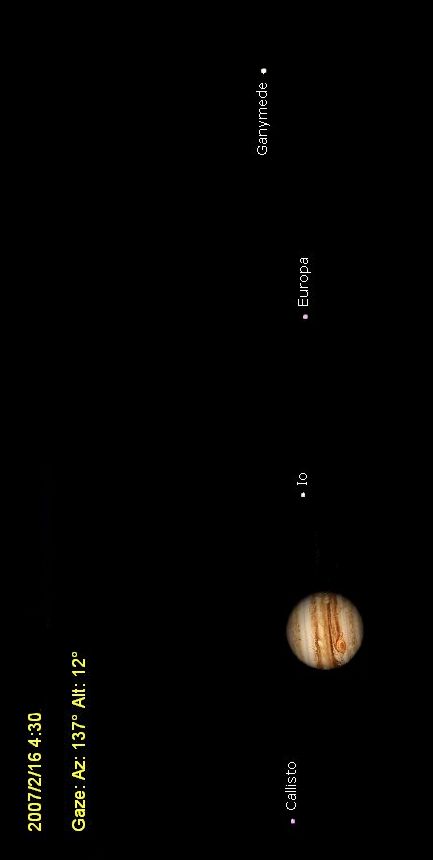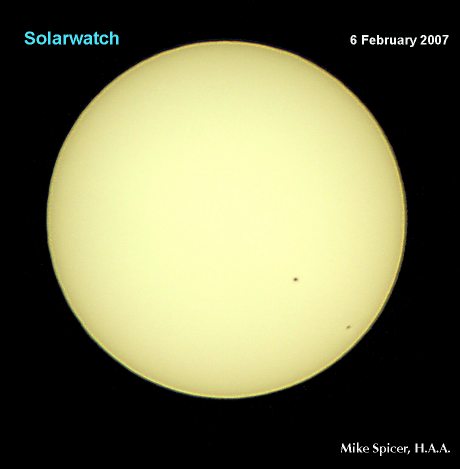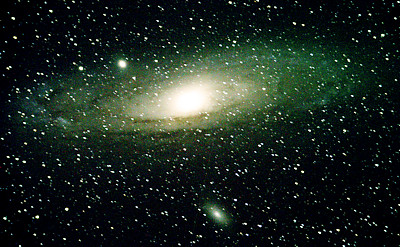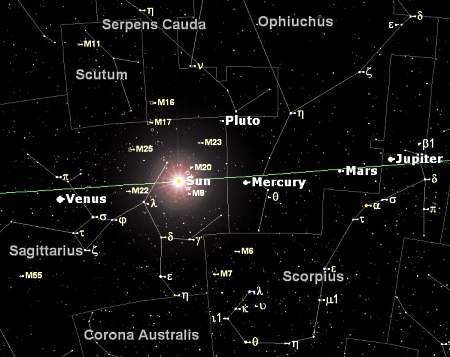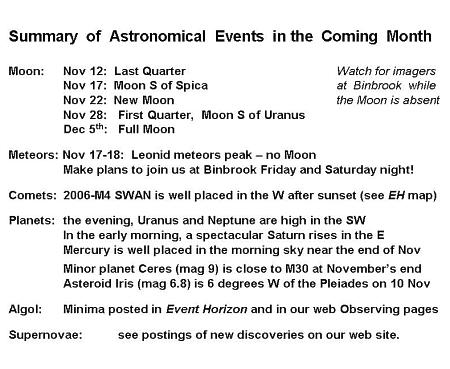BREEZING THROUGH THE SKIES, 10 February 07
With all the complaints of bad seeing lately, I was pleasantly surprised with the skies over Hamilton Saturday night, 10 February. It was a night of good transparency with long periods of great seeing after 11 pm.
As you’d know if you attended the Feb monthly meeting, Saturn’s about to eclipse the moon Iapetus in a few days. The 10th magnitude moon is half black, half white. Its orbit is inclined 7 degrees to the ring plane, so while we can still see the rings, at the moment Iapetus transits Saturn (or is eclipsed) as it orbits with a 90 day period.
I had a 5″ apo refractor set up before 7 pm and invited members to come over after preparing for a cold (-13C) and windy (20 km/hr) observing night. Jackie took up the challenge. She brought the smallest digital camera I have ever seen, a recent purchase.
Saturn was up in the East before 8 pm and I was delighted to see Iapetus just 51″ N of Titan (easy to find). It was Jackie’s first time seeing Iapetus and she said she couldn’t tell which half was black and which was white. There were a number of other moons in sight: Rhea was on the E side of the planet and when we took some 15s exposures with the Digital Rebel, Enceladus, Tethys and Dione were also visible. Jackie preferred the 3.5mm Nagler to a 4mm Radian (“I like the spacious view”) but I think the best views were in a 10mm SpearsWALER recently purchased from Khanscope. After 10 pm the seeing improved and for the first time this year I was able to see the Airy disk of various stars.
Gamma Leonis turned out to be an precious view. The two components were separated by a blackness that highlighted their golden colours. I tried to get Jackie to play the “guess the magnitude game”, but she was already across the sky, looking elsewhere in her 50mm binoculars. I think our Club 2007 observing project should be a double star booklet, double stars are such fun to see.
Jackie took some shots with her tiny digital camera, too. Then we put the ToUcam on the scope to capture some AVI files for stacking – they turned out ok despite the sometimes shakey seeing. Things got more difficult when we tried magnifying the imaging using 2x and 4x powermates. The ToUcam was now brushing patio stones and I had the darndest time getting a good focus without scraping my knuckles.
Meanwhile, our attention had turned to 5.9 magnitude U Orionis high overhead, like a small red LED at the tip of Orion’s err… club. Jackie looked at the Trapesium awhile; the nebula was extensive in 15 x 70 binoculars but only three dancing stars could be distinguished.
It was cold. Every hour we’d come in to warm up, then go back at it. As Saturn climbed to the meridian, the refractor’s eyepiece got lower and lower until my butt was on the patio stones and it was a cramped observing position to say the least. The TAL eq mount worked flawlessly; being Russian, it seemed to like the cold.
By 1 a.m. we had pictures galore, a couple of movies, frozen digits and a lot of wires all over the patio. All the equipment was brought inside to thaw (“here’s a counterweight… watch your fingers don’t freeze to it”). Then with Arcturus rising high in the East it was time to see R CrB, my favourite variable star (“almost always at maximum”) in binoculars. End of show.
Winter nights can be glorious for observing.
